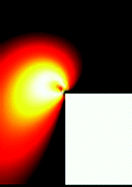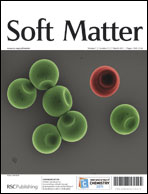Texture formation mechanisms in faceted particles embedded in a nematic liquid crystal matrix
Abstract
This paper presents a computational study of filled nematics with the aim of characterizing novel texturing processes that occur when the embedded particles have geometric singularities such as edges. As a generic texturing process due to interacting material and geometric singularities, two dimensional numerical simulations of a single square particle embedded in a calamitic thermotropic nematic liquid crystal were performed using the Landau–de Gennes model and material properties corresponding to 5CB. The results were condensed into texture phase diagrams in terms of temperature and particle size. In addition to the usual bulk defect modes found in filled nematics with smooth geometries, the square corners introduce surface defects that interact with each other or with bulk defects. The net result is that for faceted particles three modes are possible: (i) string defect modes, (ii) mixed surface/bulk defect modes, and (iii) surface defect modes. The modes' stability and transitions are explained in terms of defect energies. Accurate simulations that target transitions between the modes demonstrate critical slowing down such that long lived unstable complex textures are pinned. The present results offer new routes to engineered texturing of nematic liquid crystals by embedding faceted particles.


 Please wait while we load your content...
Please wait while we load your content...